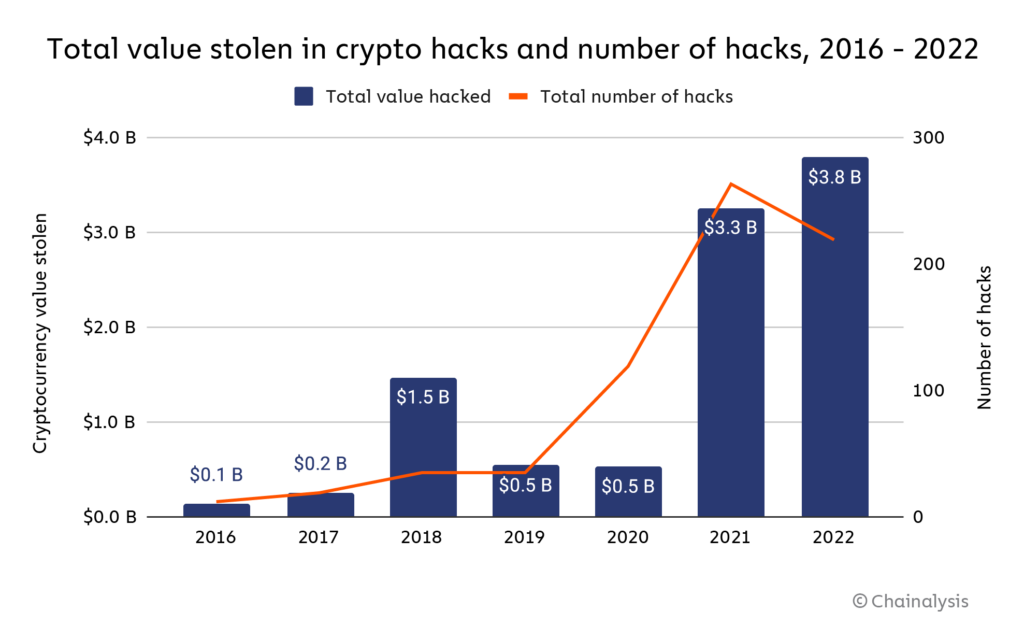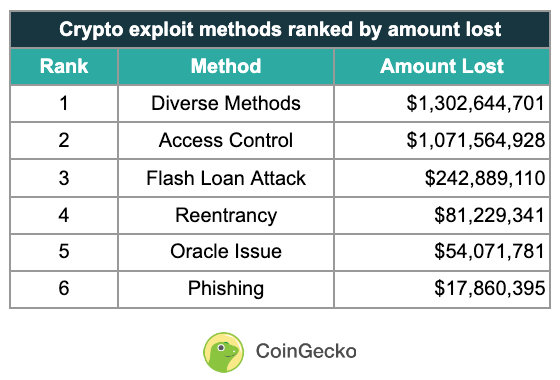
Learn essential tips to protect your crypto from hackers. Discover practices for wallet security, 2FA , and safeguarding your assets in 2024.
Author: Sahil Thakur
Published On: Thu, 15 Aug 2024 07:01:49 GMT
Protecting your crypto from hackers is a must in today’s digital landscape. Hackers constantly evolve their tactics, but you can stay one step ahead. I’ll show you simple, actionable steps to secure your assets. By the end, you’ll feel confident about how to protect your crypto from hackers , whether you’re new to the space or a seasoned investor. Let’s dive in and make sure your investments are protected.
Here are some key statistics on crypto hacking that underscore the importance of securing your assets:
These statistics emphasize the urgent need to stay informed. Taking proactive measures is critical to protecting your crypto from evolving hacking threats.

Src: Chainalysis
Cryptocurrency has revolutionized finance, but it has also attracted malicious actors. These hackers use various techniques to exploit unsuspecting users. Understanding these methods can help you protect your assets. Here’s a look at some common techniques crypto hackers employ.
Phishing is one of the most common tactics. Hackers create fake websites or emails that look legitimate. They trick users into providing sensitive information, such as private keys or login credentials.
How It Works:
Prevention:
Always verify URLs before entering sensitive information. Use two-factor authentication (2FA) for added security. Be cautious with unsolicited emails and links.
Ransomware is malicious software that encrypts a user’s files, demanding payment for the decryption key. This technique is becoming increasingly prevalent in the crypto world.
How It Works:
Prevention:
Keep your software up to date and use reputable antivirus programs. Regularly back up your data to minimize the impact of an attack.
Social engineering exploits human psychology rather than technical vulnerabilities. Hackers manipulate individuals into divulging confidential information or performing actions that compromise security.
How It Works:
Prevention:
Be skeptical of unsolicited requests for sensitive information. Verify the identity of anyone requesting confidential details through official channels.
Malware is software designed to harm or exploit devices. Crypto hackers use malware to gain unauthorized access to users’ systems and steal information or cryptocurrency.
How It Works:
Prevention:
Avoid downloading software from untrusted sources. Use comprehensive security solutions and keep your system and applications updated.
MitM attacks involve intercepting communication between two parties. In the crypto context, hackers use this technique to capture login credentials or transaction details.
How It Works:
Prevention:
Use secure connections (look for HTTPS) and avoid using public Wi-Fi for sensitive transactions. Employ VPNs to add an extra layer of security.
Pump-and-dump schemes involve artificially inflating the price of a cryptocurrency to attract investors. Once the price is high, the hackers sell off their assets, causing the price to crash.
How It Works:
Prevention:
Research investments thoroughly and be wary of investment advice from unknown or unverified sources. Be cautious of sudden market hype.
Smart contracts are self-executing contracts with the terms directly written into code. Vulnerabilities in smart contracts can be exploited by hackers to steal funds or manipulate transactions.
How It Works:
Prevention:
Ensure smart contracts are audited by reputable security firms. Avoid using contracts with known vulnerabilities or untested code.
Crypto exchanges are frequent targets for hackers due to the large amounts of cryptocurrency they hold. Attackers breach these platforms to steal user funds.
How It Works:
Prevention:
Choose exchanges with strong security measures, such as cold storage and regular security audits. Diversify your holdings across multiple platforms to reduce risk.
Address poisoning attacks involve tricking users into sending funds to a hacker-controlled address instead of the intended recipient. This method manipulates the way addresses are displayed or used.
How It Works:
Prevention:
Always double-check recipient addresses before confirming transactions. Use address whitelists and verify addresses through multiple channels if possible.

Src: coingecko
Cryptocurrency provides exciting opportunities, but it also requires vigilant security practices. Implementing effective security measures is crucial to protect your assets from theft and loss. Here are some essential strategies to enhance your crypto security.
Cold wallets, or hardware wallets, store your cryptocurrency offline. This isolation from the internet makes them less vulnerable to hacking.
How It Works:
Benefits:
Cold wallets are highly secure against online attacks and malware. They offer protection even if your computer is compromised.
Recommendation:
Choose reputable hardware wallets like Ledger or Trezor. Keep your device in a safe place.
Two-factor authentication adds an extra layer of security by requiring a second form of verification in addition to your password.
How It Works:
Benefits:
2FA significantly reduces the risk of unauthorized access. Even if someone steals your password, they cannot access your account without the second factor.
Recommendation:
Use authentication apps like Google Authenticator or Authy. Avoid SMS-based 2FA if possible, as it is more vulnerable to interception.
Strong passwords are essential for protecting your crypto accounts. Avoid using easily guessable passwords or reusing them across multiple sites.
How It Works:
Benefits:
Strong and unique passwords make it harder for attackers to gain access. They protect against brute-force attacks and password theft.
Recommendation:
Use a reputable password manager to generate and store complex passwords securely.
Keeping your software updated is crucial for security. Updates often include patches for vulnerabilities that hackers could exploit.
How It Works:
Benefits:
Regular updates reduce the risk of your software being compromised. They help protect your devices from known threats.
Recommendation:
Enable automatic updates on your devices and apps to ensure you are always protected.
Phishing is a common tactic used to steal sensitive information. It involves tricking users into providing their credentials through fake websites or emails.
How It Works:
Benefits:
Avoiding phishing scams protects your private information from being stolen. It helps prevent unauthorized access to your accounts.
Recommendation:
Verify the legitimacy of websites and emails before entering sensitive information. Always check URLs for authenticity.
Using secure connections is essential when handling cryptocurrency transactions. Always ensure you are on a secure network.
How It Works:
Benefits:
Secure connections prevent data interception and protect your information from being compromised.
Recommendation:
Avoid public Wi-Fi for sensitive transactions. Use a trusted VPN service for added security.

Securing your cryptocurrency requires implementing multiple layers of protection. Use cold wallets for storage, enable two-factor authentication, and maintain strong passwords. Regularly update your software, be cautious of phishing attempts, and always use secure connections. By following these measures, you can significantly reduce the risk of losing your crypto assets.
I hope you will implement these ways to safeguard and protect your crypto from hackers! STAY SAFU.

